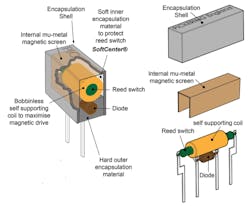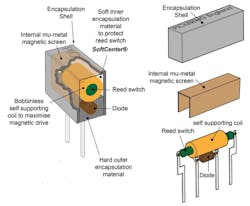How do reed relays compare with other switching technologies?
The reed relay was invented in 1936 by Bell Telephone Laboratories. Since that time, it has gradually evolved from very large, relatively crude parts to the small, ultra-reliable parts we have today. Production methods and quality systems have improved a great deal over that time, and costs have been radically reduced.
Pickering Electronics, an established reed relay manufacturer, was founded in 1968, and even then some were saying that these electromechanical devices would have a limited lifetime. Instead, the market for high-quality reed relays has increased into areas that were inconceivable in those days.
Part 1 of this two-part series answered the question, “What is a reed relay?”1 This article delves into the differences between reed relays and other switching technologies.
Electromechanical relays
Electromechanical relays (EMRs) are widely used in industry for switching functions and often can be the lowest cost relay solution available to users. Manufacturers have made huge investments in manufacturing technology to make the relays in high volumes.
There are some notable differences between reed relays and EMRs which users should be aware of:
- Reed relays generally exhibit much faster operation (typically between a factor of 5 and 10) than EMRs. The speed differences arise because the moving parts are simpler and lighter compared to EMRs.
- Reed relays have hermetically sealed contacts, which lead to more consistent switching characteristics at low signal levels and higher insulation values in the open condition. EMRs often are enclosed in plastic packages that give a certain amount of protection, but the contacts over time are exposed to external pollutants, emissions from the plastic body, and oxygen and sulphur ingress.
- Reed relays have longer mechanical life (under light load conditions) than EMRs, typically of the order of between a factor of 10 and 100. The difference arises because of the lack of moving parts in reed relays compared to EMRs.
- Reed relays require less power to operate the contacts than EMRs.
- EMRs are designed to have a wiping action when the contacts close, which helps to break small welds and self-clean their contacts. This does help lead to higher contact ratings but also may increase wear on the contact plating.
- EMRs can have much higher ratings than reed relays because they use larger contacts; reed relays usually are limited to carry currents of up to 2 A or 3 A. Because of their larger contacts, EMRs also often can better sustain current surges.
- EMRs typically have a lower contact resistance than reed relays because they use larger contacts and normally can use materials of a lower resistivity than the nickel iron used in a reed switch capsule.
Reed relays and EMRs both behave as excellent switches. The use of high-volume manufacturing methods often makes EMRs lower cost than reed relays, but within the achievable ratings of reed relays, the reed relay has much better performance and longer life.
Solid-state relays
The term “solid-state relay” refers to a class of switches based on semiconductor devices. There is a large variety of these switches available. Some, such as PIN diodes, are designed for RF applications, but the most commonly found devices that compete with reed relays are based on FET switches. A solid-state FET switch uses two MOSFETs in series and an isolated gate driver to turn the relay on or off. There are some key differences compared to a reed relay:
- All solid-state relays have a leakage current associated with their semiconductor heritage; consequently, they do not have as high an insulation resistance. The leakage current is nonlinear. The on-resistance also can be nonlinear, varying with load current.
- There is a compromise between capacitance and path resistance. Relays with low-path resistance have a large capacitive load (sometimes measured in nanofarads for high-capacity switches), which restricts bandwidth and introduces capacitive loading. As the capacitive load is decreased, the FET size has to decrease, and the path resistance increases. The capacitance of a solid-state FET switch is considerably higher than a reed relay.
- Reed relays are naturally isolated by the coil from the signal path; solid-state relays are not, so an isolated drive has to be incorporated into the relay.
- Solid-state relays can operate faster and more frequently than reed relays.
- Solid-state relays can have much higher power ratings.
- In general, reed relays behave much more like perfect switches than solid-state relays since they use mechanical contacts.
MEMS switches
MEMS switches still are largely in the development stage for general usage as relays. MEMS switches are fabricated on silicon substrates where a three-dimensional structure is micro-machined (using semiconductor processing techniques) to create a relay switch contact. The contact then can be deflected either using a magnetic field or an electrostatic field.
Much has been written about the promise of MEMS switches, particularly for RF switching, but availability in commercially viable volumes at the time of writing is very limited. The technology challenges have resulted in a number of vendors involved in MEMS failing and either ceasing to trade or closing down their programs.
Like reed relays, MEMS can be fabricated so the switch part is hermetically sealed (either in a ceramic package or at a silicon level), which generally leads to consistent switching characteristics at low signal levels. However, MEMS switches have small contact areas and low operating forces, which frequently lead to partial weld problems and very limited hot-switch capacity.
The biggest advantage for MEMS relays—if they can be made reliable—is their low operating power and fast response. The receive/transmit switch of a mobile phone, for example, has long been a target for MEMS developers.
However, at their present stage of development, it seems unlikely they will compete in the general market with reed relays as the developers concentrate on high value niche opportunities and military applications.
The future for reed relays
In more recent years, there has been a constant quest for further miniaturization. Smaller parts have required more sophisticated methods, including lasers, to create the glass-to-metal hermetic seal of the reed switch capsule. Lasers also are sometimes used to adjust the sensitivity of reed switches by slightly bending the switch blades to change the size of the contact gap. Contact plating materials and methods also have changed, particularly in the areas of cleanliness, purity of materials, and the reduction of microscopic foreign particles or organic contamination, resulting in superb low-level performance.
Reed-relay operating coils also have become smaller and more efficient thanks to advanced coil-winding techniques with controlled layering of the coil-winding wire. In the case of Pickering Electronics’ relays, the coil-winding bobbin also has been dispensed with in favor of former-less coils, which has reduced package sizes. While reed relays are a relatively mature technology, such evolution will continue in the future.
A reed relay in many ways is a near perfect switching element with a simple metallic path. A well-designed and correctly used part will give a long and reliable life. Reed relays will certainly be around for many years to come.
Reference
- Dale, G., “What is a reed relay?” EE-Evaluation Engineering, April 2016, p. 18.
About the Author
Graham Dale
Technical Director
Graham Dale began his career in telecommunications with the U.K. Ministry of Defense. In the 1970s, while working on a research project at The University of Essex sponsored by the British General Post Office (later to become British Telecom), he met John Moore, the founder of Pickering Electronics. This was in the early days of computer-controlled switching systems, and the project became a user of Pickering reed relays. Dale started working for Pickering in 1975 and remains with the company today as a technical director and applications engineer.

